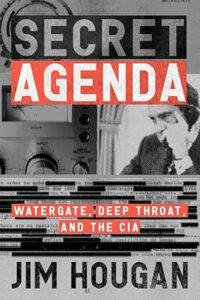When most Americans think of Watergate, they imagine a disgraced president caught red-handed, forced from office by a heroic press and a vigilant Congress.
But what if that familiar tale—repeated for decades in textbooks, media, and Hollywood—was little more than a carefully constructed myth?
As this post explores, an alternative version of events suggests Watergate wasn’t just a scandal—it was a covert operation, orchestrated not by bumbling burglars loyal to Nixon, but by powerful figures within the CIA and media elite intent on destroying him.
Rethinking the Watergate Narrative
It is important to take a fresh look at the literature surrounding Watergate—especially works that offer an “alternative” to the widely accepted story repeated by the mainstream media.
Like many major historical events, Watergate has been deliberately misreported.
The result is a version of events shaped more by propaganda than by truth.
This distortion highlights the urgent need for independent voices willing to question the narratives pushed by America’s controlled press.
Most Americans believe Watergate was simple: President Richard Nixon committed crimes, got caught, and was pushed out of office after a dramatic congressional investigation.
That’s the version taught in schools, replayed in films, and reinforced by countless news outlets.
However, one book dares to tell a different story.
Jim Hougan’s Secret Agenda: Watergate, Deep Throat and the CIA (Random House, 1984) stands apart from almost every other account of the scandal.
Hougan dives deep into the hidden side of Watergate and suggests the burglary was not a blunder—but a setup.
According to Hougan, the CIA orchestrated the break-in as a trap for Nixon and his team, using it to bring down the president from within.

Was Nixon a Villain—or a Target?
Any attempt to portray Richard Nixon in a light that differs from the standard villain narrative tends to be viewed as politically incorrect.
Suggesting that Nixon may have been as much a victim of Watergate as a perpetrator challenges decades of conventional wisdom.
What makes Jim Hougan’s research especially compelling is his deep dive into the lesser-known connections of Bob Woodward.
Most people know Woodward as the Washington Post journalist whose reporting helped take down Nixon.
But according to Hougan, there’s far more to the story.
Hougan uncovers ties between Woodward and the intelligence community—connections that raise serious questions.
Was Woodward simply reporting the news, or was he serving as a media “cut-out” for the CIA, helping execute an information war against the sitting president?
This possibility casts the entire scandal in a new light.
Hougan’s Secret Agenda doesn’t just rehash headlines. It offers a revealing look into the hidden maneuvers by Nixon’s enemies within the intelligence world.
At the same time, it highlights Nixon’s own attempts to navigate—and survive—an internal war waged at the highest levels.
For anyone truly interested in what did or didn’t happen during Watergate and its aftermath, this book remains a vital resource.
Other Works That Challenge the Watergate Myth
Another book that challenges the official Watergate story is Silent Coup: The Removal of a President (St. Martin’s Press, 1991) by Len Colodny and Robert Gettlin. This book reaches many of the same conclusions found in Jim Hougan’s work.
However, Michael Collins Piper believed Hougan’s Secret Agenda remains the more instructive of the two. Its depth and unique insights make it a standout resource.
More recently, another ambitious entry has emerged in the Watergate conversation. Lamar Waldron’s Watergate: The Hidden History—Nixon, the Mafia and the CIA (Counterpoint, 2012) adds another layer to the puzzle.
This massive volume brings together various threads—Nixon’s secret dealings, organized crime connections, and his ongoing battles with the CIA.
In many ways, it reads as a reexamination of existing material, especially regarding Nixon’s covert world.
Still, Waldron’s work is packed with compelling insights. It is especially appealing to those interested in what some call “deep politics”—the hidden power plays operating beneath the surface of public life.

A Critical Look at Lamar Waldron’s Perspective
However, a word of caution was offered by Michael Collins Piper regarding Waldron’s work.
While Watergate: The Hidden History is detailed and ambitious, it was viewed by Mike Piper as containing more “puff and fluff” than solid historical analysis.
In many respects, the book appears to echo the conventional media narrative about Nixon.
More concerning, it even seems to cast the CIA in a somewhat favorable light. From Piper’s perspective, this framing was deeply flawed.
The CIA, not Nixon, was seen as the true villain in the Watergate affair.
Waldron has also authored multiple books about the JFK assassination. These, too, were regarded with skepticism by Piper.
The recurring theme in Waldron’s JFK writings is that “the Mafia killed JFK.”
However, this conclusion conveniently avoids any scrutiny of Meyer Lansky. Instead, blame is primarily shifted toward Italian-American mob figures.
For Michael Collins Piper, this pattern of misdirection raised red flags.
As a result, Waldron’s broader body of work was considered suspect and not necessarily recommended.

Rethinking Watergate Through Suppressed Narratives
The story of Watergate has long been dominated by a familiar script—one in which a corrupt president was exposed by a heroic press.
However, as explored here, alternative accounts challenge that version and suggest a far more complex web of intrigue involving the CIA, media operatives, and political sabotage.
Michael Collins Piper believed that to truly understand Watergate, readers must look beyond mainstream accounts. Books like Secret Agenda , Silent Coup, and even the controversial works of Lamar Waldron offer varied perspectives—some compelling, others questionable.
Each one, however, reflects the urgent need to examine who really controls the narrative in American political history.
This growing body of literature raises difficult questions about power, secrecy, and manipulation at the highest levels of government and media.
